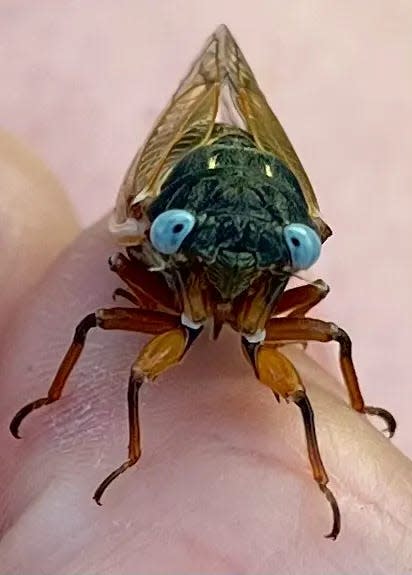'One in a million': 2 blue-eyed cicadas spotted in Illinois as 2 broods swarm the state
Seeing a cicada with blue eyes has been described as a "one in a million" possibility. In Illinois, amid the swarms of insects with red eyes, a blue-eyed cicada has been seen twice this year, so far.
A blue-eyed cicada was donated to the Field Museum of Natural History in Chicago after it was found by a family in the Chicago suburbs. It was first discovered by four-year-old Jack Bailey, who found it in his family's yard in Wheaton, Illinois. His 14-year-old sister, Caroline, noticed its blue eyes and showed it to their mom, Greta Bailey.
"I thought it was cool and unique and had not heard that blue-eyed cicadas even existed," Greta Bailey told the Field Museum. "I took a few pictures and Caroline let it go. Well, after telling my family about it, we came to find out how rare they are and were kicking ourselves for not keeping it. A couple hours later, Caroline and her twin sister Addison, took flashlights outside to go look for it where Caroline had let it go. Amazingly, they were able to find it again and now we knew to not let it go."

According to the Field Museum, the female cicada is the first blue-eyed cicada to be part of the museum's collection. Its eyes were blue instead of the typical red-orange due to a mutation.
The cicada has since died, but is pinned and is on display now in the museum's Science Hub.
Another blue-eyed cicada was spotted by Kelly Simkins, owner of the traveling zoo Merlin's Rockin' Pet Show. Simkins told USA TODAY the "one in a million" cicada was spotted early Monday in Orland Park, Illinois, another Chicago suburb.
Which cicada broods are in Illinois?
Illinois is one of two states hosting both broods of cicadas emerging this year: Brood XIX and Brood XIII.
Brood XIX has emerged in the southern and central part of the state, and is also found in states across the Southeast. Brood XIII is concentrated in the Midwest, found in Northern Illinois, Wisconsin, Iowa, Indiana and Michigan.
How long will the cicadas be above ground?
How long cicadas live depends on their brood and if they are an annual or periodical species.
The two periodical broods this summer are Brood XIX, which have a 13-year life cycle, and Brood XIII, which have a 17-year life cycle.
Once male and female periodical cicadas have mated and the latter has laid its eggs, the insects will die after spending only a few weeks above ground ? anywhere from three to six weeks after first emerging.
That means many of this year's periodical cicadas are set to die in June, though some could die off in late May or July, depending on when they emerged.
The nymphs of annual cicadas remain underground for two to five years, according to the Missouri Department of Conservation. These cicadas are called "annual" because some members of the species emerge as adults each year.
2024 cicada map: Check out where Broods XIII, XIX are emerging
The two cicada broods were projected to emerge in a combined 17 states across the South and Midwest. They emerge once the soil eight inches underground reaches 64 degrees, beginning in many states in April and May and lasting through late June.
The two broods last emerged together in 1803, when Thomas Jefferson was president.
This article originally appeared on USA TODAY: Cicadas with blue eyes spotted in Illinois, a very rare occurrence